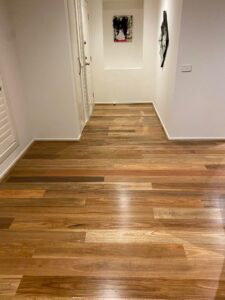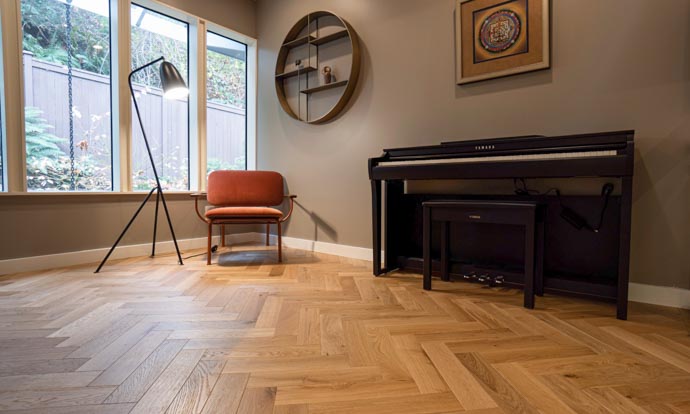Are you considering sanding and polishing your timber floors? It’s a great way to breathe new life into your home and add value to your property. However, before you get started, it’s important to understand the process and decide whether you should tackle the job yourself or hire a professional.
While it may be tempting to save money by doing it yourself, it’s crucial to consider the risks involved. Sanding and polishing timber floors requires specialized equipment and expertise. Without proper training, you could damage your floors or even injure yourself.
In this article, we’ll explore why hiring a professional is often the best option when it comes to timber floor sanding and polishing. We’ll also discuss how long it takes, how much it costs, and provide tips for maintaining your newly sanded and polished floors.
1. Can you do it yourself?
You might be tempted to tackle timber floor sanding and polishing yourself, but before you do, consider the time, effort, and potential mistakes that could end up costing you more in the long run.
While DIY projects can be rewarding, they also come with their own set of challenges when it comes to floor restoration. Sanding and polishing a timber floor requires specialized equipment that can be costly to rent or purchase.
Additionally, there is a certain level of skill needed for proper technique when sanding and polishing floors. Without experience in this field, it may take longer than expected to complete the project or result in an uneven finish. This could lead to having to redo portions or even the entire job over again.
Furthermore, attempting timber floor sanding and polishing by yourself could result in damaging your flooring beyond repair if not done correctly. Sanding too aggressively or using incorrect grits can cause dents or scratches on your hardwood flooring that will require professional attention to fix.
While DIY projects are fun and cost-effective for some home renovations, it’s important to weigh the costs versus benefits before attempting timber floor sanding and polishing yourself. With equipment requirements as well as specific skill levels needed for quality results without causing damage; hiring professionals may actually save you time and money in the long term compared to doing it all by yourself – so think twice before tackling this task alone!
2. Why do you need a professional?

Hiring an experienced expert to revamp your hardwood flooring can result in a beautifully renewed space that adds value and charm to your home. Although DIY timber floor sanding and polishing may seem like a cost-effective solution, doing it yourself can lead to costly mistakes that could damage the flooring irreparably. The benefits of hiring a professional are plenty, but the most important one is expertise.
Expertise is key when it comes to floor sanding and polishing. A professional knows how to assess the condition of the flooring, determine the best type of equipment needed for sanding and polishing, and choose the right finishing products for optimal results. An expert also has access to specialized tools that aren’t readily available to DIY enthusiasts.
With their knowledge and experience, they can get your floors looking better than ever before. Quality control is another reason why you should hire a professional for timber floor sanding and polishing. They have strict quality assurance procedures in place that ensure every step of the process is done correctly.
From removing any dirt or debris from the surface, filling gaps in between boards with wood filler, buffing out scratches or dents on individual planks – all these steps require precision which only an experienced person can deliver. Hiring a professional for timber floor sanding and polishing will provide you with numerous benefits such as expert advice, exceptional quality workmanship, and peace of mind knowing your floors are being taken care of by someone who knows what they’re doing.
So if you want beautiful hardwood floors that look brand new again without any hassle or worry about damaging them further – call in an expert today!
3. How Long it takes to sand and polish?
The duration of the sanding and polishing process for hardwood floors depends on various factors, such as the size of the area and the condition of the surface. The time required can range from a few hours to several days. It’s essential to hire a professional who has experience in sanding and polishing timber floors. They’ll use proper equipment and techniques that ensure your floor looks good as new.
The first step in sanding a timber floor is to remove any existing coatings or finishes. This takes about 2-4 hours per room, depending on its size. After this, the floor needs to be sanded using different grits of sandpaper until it becomes smooth and even. This process can take anywhere between 10-20 hours per room, based on how much work is needed to remove scratches or unevenness.
Once the sanding is complete, it’s time to apply polish or stain. This usually requires two coats for optimal results, with each coat taking around 2-4 hours per room. The drying time between each coat varies depending on whether oil-based or water-based products are used. On average, you should allow at least six hours for each coat before proceeding with another layer.
Timber floor sanding and polishing is not an easy task to undertake alone if you want quality results. Hiring a professional ensures that your flooring project gets done correctly while saving you valuable time and effort. The duration of the process depends on many variables such as size, condition, equipment used, and techniques employed by professionals who know how to do it right!
4. How much it cost?
Looking to give your hardwood floors a fresh new look? The cost of timber floor sanding and polishing can vary depending on several factors. In general, the price for this service can range from $25-$50 per square meter. This cost breakdown includes labor, materials, and equipment.
However, keep in mind that prices may differ based on the condition and size of your flooring. If you’re looking for budget-friendly options, there are some DIY alternatives available. You can rent a floor sander and do it yourself, which could save you some money in labor costs.
However, keep in mind that sanding requires knowledge and experience. If done improperly, it could lead to permanent damage to your floors. Another budget-friendly option is to opt for a less extensive sanding process called ‘screening.’ This involves using a screen instead of sandpaper to remove the top layer of finish without fully sanding down the wood.
It’s important to note that while DIY options may seem cheaper at first, they require time, effort, and potentially costly mistakes if done incorrectly. Hiring professional services not only ensures quality work but also saves you time and hassle in the long run. So before deciding on what option suits your needs best – weigh out all pros and cons!
5. Tips for Maintaining Your Newly Sanded and Polished Floors
Keep your newly sanded and polished floors looking their best with these easy maintenance tips! After investing in the time and money to have your timber floors sanded and polished, it’s important to maintain them properly. Not only will this extend the longevity of your flooring investment, but it’ll also keep your home looking beautiful for years to come.
One of the most important aspects of maintaining your timber floors is floor cleaning techniques. Be sure to sweep or vacuum regularly, as dirt and debris can scratch the surface of your floors over time. When mopping, use a damp mop rather than a soaking wet one to prevent water damage.
Additionally, avoid using harsh chemicals or abrasive cleaners that can damage the polish on your floors. Preventing scratches is another key factor in maintaining newly sanded and polished timber floors. Use furniture pads underneath all chairs, tables, and other heavy pieces of furniture. This’ll help prevent scratches caused by movement across the floor’s surface.
Also be mindful when moving heavy items such as appliances or furniture – always lift them instead of dragging them across the floor. Choosing the right polish is essential for keeping your newly sanded and polished timber floors looking their best. Make sure you choose a high-quality polish that’s specifically designed for timber flooring.
Avoid wax-based products, which can leave a cloudy residue over time. It’s also important to follow manufacturer instructions carefully when applying any type of polish. By implementing these easy maintenance tips, you can keep your newly sanded and polished timber floors looking beautiful for years to come!
By taking proper care of them through regular cleaning practices, preventing scratches from occurring, as well as choosing quality polishes designed specifically for timber flooring – you can ensure that they remain an asset in both aesthetics and function within any given space!
6. Conclusion
Congratulations! You’ve successfully sanded and polished your timber floors. However, it’s important to remember that this is a task best left to professionals. While DIY options may seem tempting, the risks of damaging your floors and not achieving the desired results far outweigh the benefits.
Professional floor sanding and polishing services take anywhere from two to five days depending on the size of the area being serviced. The cost also varies according to factors such as location and type of finish desired. But regardless of these variables, investing in professional services ensures that you get long-lasting, high-quality results.
To maintain your newly sanded and polished floors, it’s important to avoid dragging heavy furniture across them or wearing spiked shoes. Regular cleaning with soft-bristled brushes and damp mops is also recommended to keep dirt and debris from accumulating on the surface.
With proper care, your newly polished floors will continue to look beautiful for years to come!
